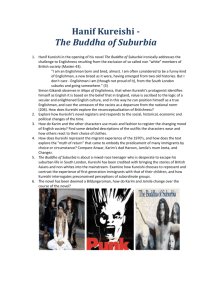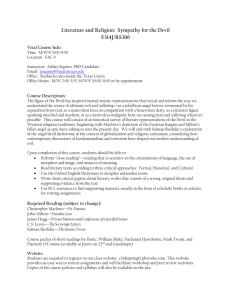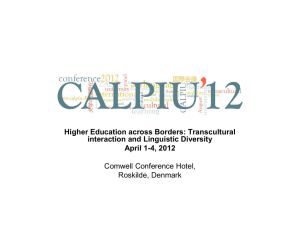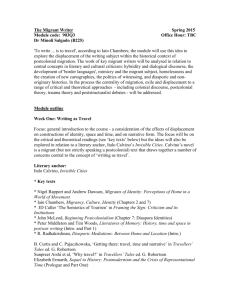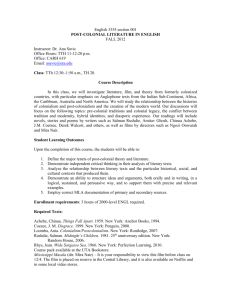Postcolonial Reification in Rushdie and Kureishi's Novels
advertisement
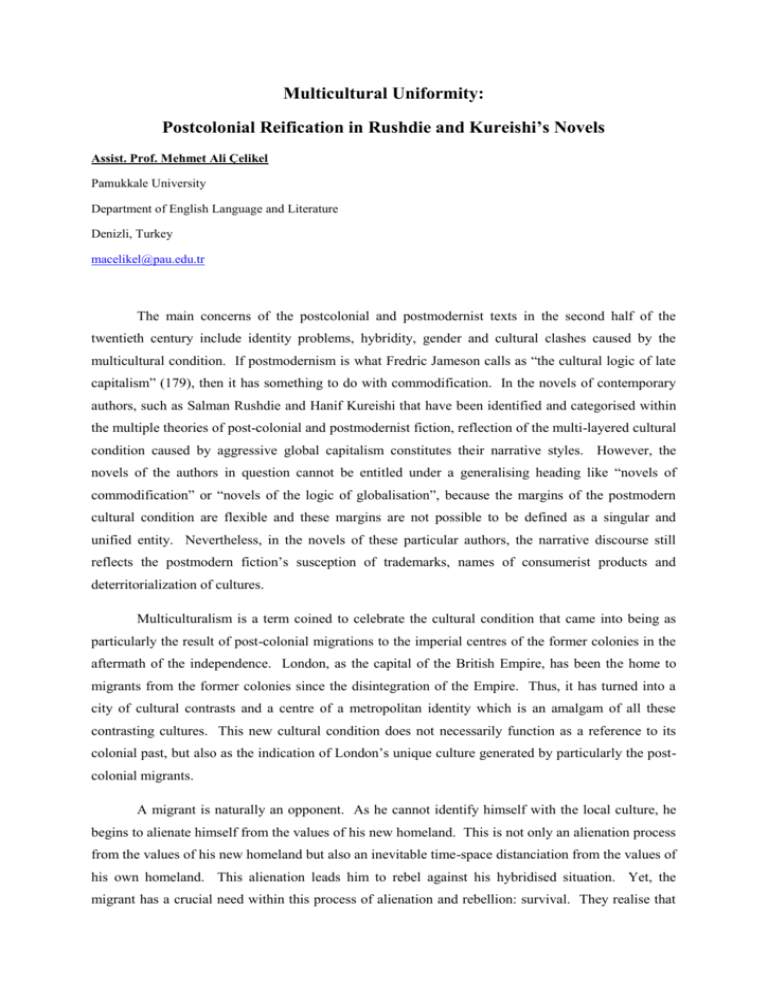
Multicultural Uniformity: Postcolonial Reification in Rushdie and Kureishi’s Novels Assist. Prof. Mehmet Ali Çelikel Pamukkale University Department of English Language and Literature Denizli, Turkey macelikel@pau.edu.tr The main concerns of the postcolonial and postmodernist texts in the second half of the twentieth century include identity problems, hybridity, gender and cultural clashes caused by the multicultural condition. If postmodernism is what Fredric Jameson calls as “the cultural logic of late capitalism” (179), then it has something to do with commodification. In the novels of contemporary authors, such as Salman Rushdie and Hanif Kureishi that have been identified and categorised within the multiple theories of post-colonial and postmodernist fiction, reflection of the multi-layered cultural condition caused by aggressive global capitalism constitutes their narrative styles. However, the novels of the authors in question cannot be entitled under a generalising heading like “novels of commodification” or “novels of the logic of globalisation”, because the margins of the postmodern cultural condition are flexible and these margins are not possible to be defined as a singular and unified entity. Nevertheless, in the novels of these particular authors, the narrative discourse still reflects the postmodern fiction’s susception of trademarks, names of consumerist products and deterritorialization of cultures. Multiculturalism is a term coined to celebrate the cultural condition that came into being as particularly the result of post-colonial migrations to the imperial centres of the former colonies in the aftermath of the independence. London, as the capital of the British Empire, has been the home to migrants from the former colonies since the disintegration of the Empire. Thus, it has turned into a city of cultural contrasts and a centre of a metropolitan identity which is an amalgam of all these contrasting cultures. This new cultural condition does not necessarily function as a reference to its colonial past, but also as the indication of London’s unique culture generated by particularly the postcolonial migrants. A migrant is naturally an opponent. As he cannot identify himself with the local culture, he begins to alienate himself from the values of his new homeland. This is not only an alienation process from the values of his new homeland but also an inevitable time-space distanciation from the values of his own homeland. This alienation leads him to rebel against his hybridised situation. Yet, the migrant has a crucial need within this process of alienation and rebellion: survival. They realise that the post-colonial world is a capitalist one that leads them to ambivalence as to whether integrate into the new culture and reject their identities or to hold on to their own values. As a result of the need for survival, the post-colonial migrants begin to isolate themselves from the label of post-colonial identities attached to them and succumb to the values of the western capitalist world, turning their cultural products into commodities. Thus, the post-colonial migrants begin to lose their identities and are hybridised in multicultural London. This study, therefore, aims to scrutinise the concept of reification from three different perspectives. The first is the reification of the cultural values and cultural objects of the migrants. This process includes the commodification of the migrants’ traditional food, clothes and garments in order for them to survive in their new dwelling place. The second one is their cultural fetishism that occurs through their obsession in using western products and trademarks to appear more western. The third one, finally, is the reification of local traditional and religious values and ceremonies through the influence of western products and brand names before the independence in the colony. This process of reification stands out as the repulsion of identities and beliefs. Postcolonial novels by the postcolonial British authors reflect not only an anti-imperialist stance in the aftermath of the colonial enterprise, but also a new form of hybridised identity for the characters of both Indian and English origin, thus suggesting a new postcolonial culture. Dislocation of culture and identity through the process of hybridisation produces its own resistance towards the changing of values, principles and beliefs. In this respect, Salman Rushdie’s and Hanif Kureishi’s novels portray postcolonial individuals who attempt to resist the cultural hybridisation by preserving their traditional and religious identity. However, their resistance turns out to be commodified in terms of their meals, clothes and even beliefs. Within this intense reification in post-colonial texts, identities succumb to the models constructed by the market which totalizes and accumulates all individuals under a cultural uniformity. From the “coca-colonization of the planet” in Rushdie’s The Satanic Verses to reification of both colonial and postcolonial identities via the insistence of ethnic clothing in opposition to popular brands in Kureishi’s The Buddha of Suburbia and The Black Album, literature of the postcolonial period, then, reflects Western products as the forms of cultural fetishism in order for postcolonial migrants to be more westernised, while it reflects the ethnic characteristics of the postcolonial individuals not only as the sources of their means of cultural preservation but also as their means of financial survival. In Hanif Kureishi’s novels, London is presented as a global city that accumulates the global differences and cultural varieties, which function well to exemplify the reification of cultural values and cultural objects of the migrants. John Clement Ball refers to Kureishi’s use of London in his texts as his “remarks that reflect [the texts’] overlaying of analogous global space on local metropolitan space” (21). As an author of culturally diverse characters and stories, he not only embodies the local space as the reflection of the globalised cultural condition but also internalizes the cultural diversity as the core of his characters’ identity. In a sense, the global space becomes the local space in London. In Gabriel’s Gift, the global cultural products that seem to be alien leak into the local space: The city was no longer home to immigrants only from the former colonies, plus a few others: every other race was present, living side by side without, most of the time, killing one another. It held together, this new international city called London – just about – without being unnecessarily anarchic or corrupt. There was, however, little chance of being understood in any shop. Dad once said, “The last time I visited the barber’s I came out with a bowl of couscous, half a gram of Charlie and number two crop. I only went in for a shave!” (Gabriel’s Gift, 8) A daily practical need like having a shave at the local barber’s is combined with the introduction of “couscous”, a type of food which is alien to the local environment. Since food functions as the intensifier of immigrants’ cultural representation, it not only turns into a means of survival but also into the representation of the immigrants’ cultural background, while it gets commoditized. Then, “couscous” becomes reified because it is stripped of its cultural identity and is turned into a commodity. Besides, it is not only unusual to see “couscous” being sold at a barber’s, but also surprising to find a type of non-English food in the local neighbourhood. Thus, the metropolis becomes a melting pot of cultural contrasts and the marker of an identity which is an amalgam of these contrasting cultures. Kureishi does not depict the multicultural condition as a reference to the colonial past, but as the cultural characteristics of London. Kureishi’s London is, therefore, a setting for many global cultural motives, which originate from within London. Bart Moore-Gilbert suggests that Kureishi’s themes and concerns are perceived as cosmopolitan or “even exotic” by the readers outside Britain, but they seem local particularly to London-based readers (1). The multicultural condition in Kureishi’s London does not only stem from the colonial past, but also from the objectification and commodification in global capitalism. Therefore, the introduction of global motives functions to modify the local habits and interests in his novels. In Gabriel’s Gift, coffee is presented as one of these modifiers of habits: Even ten years ago it was difficult to get a decent cup of coffee in this town. Now people threw a fit if the milk wasn’t skimmed to within a centimetre of its life and the coffee not picked on their preferred square foot of Arabia. (Gabriel’s Gift, 8) The change in daily habits like having coffee in the above example appears to be caused by the commodification of the immigrants’ cultural products. Sukhdev Sandhu suggests that Kureishi is “relaxed about the changes the capital might wreak” on immigrant identity as well as on the cultural identity of London, because for many immigrants London is not a place to refashion themselves, but a place to migrate and inhabit for financial reasons (154). This process is taken further by Arif Dirlik and called as “global unity” created by trans-nationalisation of production (349) obviously made easier in the aftermath of colonialism. Dirlik’s assumption is that the world is homogenized both economically and culturally (349). In Something to Tell You, Kureishi focuses on this homogenisation to forefront the reification of the figures of divinity: When I had more time, I liked to walk up through Shepherd’s Bush market, with its rows of chauffer-driven cars parked alongside Goldhawk Road Station. Hijabed Middle Eastern women shopped in the market, where you buy massive bolts of vivid cloth, crocodile skin shoes, scratchy underwear and jewellery, ‘snide’ CDs and DVDs, parrots and luggage, as well as illuminated 3-D pictures of Mecca and of Jesus. (Something to Tell You, 10) Ethnicity becomes not something to be integrated into the host culture, but it turns into a rarefied commodity. The “3-D pictures of Mecca and Jesus” sold side-by-side are no more the representatives of their spiritual “use value”. On the contrary, they are stripped of their religious meaning by acquiring, in Marxist terms, an “exchange value”, and the improbable cooperation between Jesus and Mecca is presented to consumers’ taste on a street market stall. Angela McRobbie interprets the street markets as the places that function “as a daytime social meeting place” where “money and goods” are exchanged, and she stresses that “wherever immigrant groups have arrived and set about trying to earn a living in largely hostile environment a local service economy in the form of a market has grown up” (374). Arguing on globalization and commodification, Timothy Bewes asserts that “the concept of reification presupposes the assimilation of all cultures to a single culture” (21). Multiculturalism is, then, the commercialisation of even ethnicity, in which case, hybridity, as defined by Kureishi on the streets of London, is commodified rather than being hybridised, like the illuminated picture of Mecca and Jesus sold on the same stall. Thus, commodification and reification disguise the postcolonial cultural scene. When it comes to speaking of cultural fetishism, the characters that Kureishi describes, despite being analogous with the multiplicity of the global cultural representation in a local setting, appear to be similar to each other in that they all reflect consumerism by their clothes, each of them being global fashionable brands. His non-white characters like Karim and Changez in The Buddha of Suburbia or Shahid in The Black Album, as the representatives of the second generation of post-colonial immigrants, are all presented through their body ornamentation, mutilation or deformity. Karim and Shahid decorate their bodies by their hair style and their clothing. Their body decoration, in most cases, functions to cover their cultural identity rather than emphasising it. Karim, for instance, dresses up like a pop icon in order to perform Englishness and whiteness more effectively: I wore turquoise flared trousers, a blue and white flower-patterned seethrough shirt, blue suede boots with Cuban heels, and a scarlet Indian waistcoat with gold stitching around the edges. I’d pulled on a head band to control my shoulder-length frizzy hair. (The Buddha of Suburbia, 6) Karim’s room is a cultural collage including a Jimi Hendrix poster, a poster of the “Easy Rider” movie, a poster of “The Doors”, retro clothes scattered around the room that bears all the kitsch elements of ‘70s. However, his brown body signifies his ethnicity and cultural clash with the western cultural domination in his room. When Karim is together with his English friend Charlie, whom he idolizes, he is reduced to a bodily existence merely. Charlie advises him to “dress less” because he looks “a bit like a pearly queen” (16). Charlie also advises him to wear “Levi’s” jeans and take his headband off, after which Karim immediately takes it off (16). In order to look more English and get more admission into Englishness, Karim represents his body in western brands. His body, then, turns into a performance of cultural fetishism. Through his desire of being and feeling like a westerner, he makes Levi’s a cultural fetish to complete his performativity. Judith Butler asserts that What are being performed are the cultural norms that condition and limit the actor in the situation but also in play are the cultural norms of reception, which may or may not accord with the ones that are constituting a situation so that we actually have a retrospective of constitution of the performance through the norms of reception – and this can produce really interesting problems of cultural translation and cultural misunderstanding. And those problems are very productive. (346) Butler suggests that racial identity depends upon the representation of bodies, both in physical and performative terms. In this way, people outside of a certain race classification like Karim are Othered and must choose to either perform their societal racial norms or take on the potential problems of racial performativity. Karim’s purpose is to conceal his otherness by using garments and objects that are culturally attributed to the west. He experiences otherness in his racial identity and thus he attempts to repress this experience by rejecting the fixed racial roles and models of Indianness attached to him. As a result he acquires an English identity falsely constructed via culturally western clothing garments. Karim’s ethnic identity and cultural mix multiply the collage and connotations created by these western products. Kureishi offers a version of multiculturalism similar to the demands of performativity that change according to the societal needs. His search for authenticity rejects self-definition based solely on them. The challenge of the novel is how Karim fails to identify himself in a multicultural space based on race and ethnicity. Kureishi demonstrates performativity in practice, creating a visualization of some of the tenets of the theory as Karim struggles to define himself. Karim’s characterization offers both a literary example of how performativity through the reification of cultural values and objects can work in conjunction with the search for identity. In The Black Album, Shahid, the protagonist of the novel, is a young member of the second generation of post-colonial Pakistani immigrants. Being born in London, he feels English very much like Karim in The Buddha of Suburbia. His desire to conceal his otherness and look more English to be admitted into the English culture is provided by means of clothing garments bearing famous western brand names as in the case of Karim in The Buddha of Suburbia. In the dormitory of the college in London where he studies, Shahid is surrounded by a group of radical Islamic students who are originally from Pakistan. Shahid’s “Gap jeans”, “Fred Perry” and “Paul Smith” shirts and “Italian T-shirts” (22) function to emphasize his integration within the western culture by concealing his otherness. At the same time, however, these brand names also function to emphasize his difference from his radical friends who insist on wearing traditionally non-western garments to signify their antiwesternness. The third type of reification in this study is the reification the local traditional and religious values in the colony itself as an outcome of the colonial venture. Salman Rushdie’s The Satanic Verses in terms of its cultural deterritorialization and commodification of myths ruptures the conventional narration by not only forming a multi-layered structure but also recreating and satirizing religious myths through the deployment of commodities. This type of reification stands out as a result of the western products introduced in the colony by imperialism and the colonial venture. Gibreel Farishta, in The Satanic Verses, is a film star famous for acting in theological movies in India. In a satirical contradiction to his roles in theological movies, for which he is famous, he loses his faith soon after his arrival in London. His new identity offers what Amin Malak calls as “the clash of cultures and the conflict of representations” (183). A theological movie star turns into a nonbeliever, and a theatre actor becomes a voice-over actor for commodities. Catherine Cundy regards their condition as the result of a cultural “dislocation” (68). By ironically reformulating these postcolonial identities, Rushdie satirises the aggressive capitalist tendency of imperialism by harshly deploying aggressive marketers, brand names and strong commodification. In the opening pages of the novel, when the two expatriates fall off the crashed aircraft, Gibreel begins, in the air, to sing an old Indian song that pre-informs the general halo of the novel: ‘O, my shoes are Japanese,’ Gibreel sang, translating the old song into English in semi-conscious deference to the uprushing host-nation, ‘These trousers English, if you please. On my head, red Russian hat; my heart’s Indian for all that.’ (5) Gibreel’s song foreshadows the cultural bricolage in the novel. Gibreel and Saladin represent a hybridised nation that has lost its national identity. According to the song, this loss of identity is caused by the economic hegemony of non-national products. This song not only suggests a cultural bricolage, but also informs the reader of the upcoming tone of the novel that clashes myths with commodification. Both religion and nation are under the same economic hegemony. Hal Valance, one of the minor characters in the book, is a racist advertising executive who used to “employ [Saladin] for the voice-overs in his commercials” (Brian Finney 82). However, he “uses market research to justify removing all signs of black immigrants from his commercials” and sacks Saladin (Finney 82), because he is too alien. Finney regards this as Rushdie’s use of black comedy “evident in the passages concerning politics, capitalist greed and racism” (82). The use of black comedy through representations of aggressive capitalism and racism enables Rushdie to retell and parody the mythical and heroic images in a contemporary setting. The most striking religious myth that clashes with commodification is Gibreel’s final dream about a walk of pilgrimage organised by Ayesha. She is a girl who eats nothing but butterflies and persuades a whole village to go on a pilgrimage with her. Mishal, who has cancer, is one of the villagers to join Ayesha. She believes that her cancer will disappear if she walks to Mecca: ‘It is the angel’s will that all of us, every man, and woman and child in the village, begin at once to prepare for a pilgrimage. We are commanded to walk from this place to Mecca Sharif, to kiss the Black Stone in the Ka’aba at the centre of the Haram Sharif, the sacred mosque. There we must surely go.’ (235) Her husband Mirza’s attempts to stop her are humorous and suggest a realism that overtakes magic: ‘… When the waters of the ocean part, where will the extra water go? Will it stand up sideways like walls?...’ He began to cry, and fell on his knees, with his forehead still pressed against the wall. His dying wife came up and embraced him from behind. ‘Go with the pilgrimage, then,’ he said, dully. ‘But at least take the Mercedes station wagon. It’s got air-conditioning and you can take the icebox full of Cokes.’ (239) Rushdie creates a grotesque image by parodying an Islamic duty and a holy myth. The burlesque generated by the clash of eastern magical reality with western products indicates how powerfully capitalism dominates religious and national identities and how influentially it demonises them. An air-conditioned car and cold fizzy drinks are suggested as facilitators of a religious duty, thus decreasing the reverence of such a task. The duty of pilgrimage is taken out of its local and spiritual paradigms and converted into a secular task through an impious commodification. Salman Rushdie presents the post-modern cultural condition of the world as an impediment of authenticity and religious and national identities. In one of his interviews, Rushdie points to the fact that television, which is a cheap and crude source of information, has a coarsening influence (1996: 57). He thinks of the religious soap operas produced for Indian television channels and observes how greatly they changed the concepts of divine concepts, because one just sits in the living room and can switch off the TV set that “fits in the corner of the room” (1996: 57). Considering that television has become the greatest source of information that can be switched off at any time, everything presented on television is crudified. Rushdie calls this “Coca-Colonization” in The Satanic Verses: Amid all the televisual images of hybrid tragedies – the uselessness of the mermen, the failures of plastic surgery, the Esperanto-like vacuity of much modern art, the Coca-Colonization of the planet – … (406) Akbar S. Ahmed considers the world as a “television box” that consolidates “Western consumerism” (210-211). He identifies postmodernism “as the era of the media” and in this era, television “constitutes a radical break with the past” (211). Rushdie represents the eclecticism and juxtaposed images of the postmodern condition. In this representation, consumerism and media surround everything, including religion, in contemporary culture. The walk of pilgrimage organised by Ayesha succeeds to elicit attention from media and the business world in The Satanic Verses. However, this interest in the pilgrimage is far away from its spiritual content: The story of the village that was walking to the sea had spread all over the country, and in the ninth week the pilgrims were being pestered by journalists, local politicos in search of votes, businessmen who offered to sponsor the march if the yatris would only consent to wear sandwich boards advertising various goods and services … (488) In Damian Grant’s words, Rushdie’s fiction calls into question the “value-free world of contemporary culture” wherever it may be found (87), and he presents capitalist marketing as what demonises the divinity. The values of consumer culture become more important than the values of religion and nationality. While Grant reads the text as the representative of the value-free world, this study reads the novel in terms of its representation of greedy commodification of values, which, in a very similar manner to that of Grant, eventually leads to a world devoid of non-monetary values. Rushdie recycles images, deconstructs religion and turns it into a commodity for the culture of television. He not only parodies religious myths through commodification, but also satirises the consumer culture that interferes with everything. The interference of consumer culture provides capitalism, in Lyotard’s terms, with “the power to derealize familiar objects, social rules, and institutions to such a degree” that reality can only be realised as nostalgia or mockery (74). If religion is an institution, then it is derealized by capitalism in Rushdie’s text. The holy pilgrimage is derealized to a degree of mockery, since it is a contemporary attempt that cannot avoid the bombardment of brand-names and advertisements. When power is possessed by capital, to quote Lyotard once again, contemporary culture becomes eclectic (76). Rushdie uses the eclecticism of contemporary culture in his representation of the religious and national values of the post-colonial migrants, who lose their identity not only after post-colonial migration, but also through the commodification of their values. To conclude briefly, the multicultural condition as the outcome of post-colonial migrations in the second half of the twentieth century has been subject to reification. This reification, however, functioned in various ways. The first type of reification has been observed as the commodification of cultural values and objects like traditional types of food and icons of religious beliefs, which were regarded as the means of survival for the immigrants. The second type of reification has come out as cultural fetishism in which the post-colonial immigrant adapts himself to the local culture by using the western cultural icons and symbols to appear more western and to conceal his authentic origin. The third type on the other hand mostly occurs in the form of intrusion of western brand names in the colony, in which case the colonial local culture is dominated by western products. The common point in all these three types is the objectification of culture which leads to uniformity. The more the cultures are reified the more they are alike since reification strips them of their spiritual and traditional meaning and content. Last but not the least; multiculturalism is juxtaposed with cultural uniformity introduced by global capitalism which leads all cultures to sameness. No matter how London, as the imperial centre, is populated with immigrants from the former colonies in all parts of the world, the objectification and commodification of their cultures into exchange value conceal the multicultural scenery of London and turn it into a cultural uniformity. Thus, it is no more the differences that count but it is the uniformity that dominates the new internationalism. BIBLIOGRAPHY AHMED, Akbar S. Postmodernism and Islam. London & New York: Routledge. 1992. BALL, John Clement. “The Semi-Detached Metropolis: Hanif Kureishi’s London,” in ARIEL: A Review of International English Literature, 27:4, October 1996. 7-27. BEWES, Timothy. Reification or the Anxiety of Late Capitalism. London: Verso. 2002. BUTLER. “Changing the Subject: Judith Butler’s Politics of Radical Resignification” The Judith Butler Reader. Ed. Sara Salih. Malden, MA: Blackwell Publishing. 2004. 32556. CUNDY, Catherine. Salman Rushdie. Manchester & New York: Manchester University Pres. 1996. DIRLIK, Arif. “The Postcolonial Aura: third World Criticism in the Age of Global Capitalism.” Critical Inquiry. 20 (Winter 1994). 328-56. FINNEY, Brian. ‘Demonising Discourse in Salman Rushdie’s “The Satanic Verses”’, in ARIEL: A Review of International English Literature. 29:3, July 1998. 67-93. GRANT, Damian. Salman Rushdie. Plymouth: Northcote House. 1999. LYOTARD, Jean-François. The Postmodern Condition: A Report on Knowledge. Translated from the French by Geoff Bennington & Brian Massumi. Manchester: Manchester University Pres. 1984. MALAK, Amin. ‘Reading the Crisis: The Polemics of Salman Rushdie’s “The Satanic Verses”’, in ARIEL: A Review of the International English Literature. 20:4, October 1989. 176-186. MCROBBIE, Angela. “Second-Hand Dresses and the Robe of the Ragmarket.” In Guins, R. & Cruz, O. Z. (eds.). Popular Culture: A Reader. London: Sage Publications. 2008. 37282. MOORE-GILBERT, Bart. Hanif Kureishi: Contemporary World Writers. Manchester: Manchester University Press. 2001. RUSHDIE, Salman. “Interview: Salman Rushdie talks to the London Consortium about The Satanic Verses’”, Critical Quarterly, vol. 38, no. 2, (Summer 1996). 51-70. SANDHU, Sukhdev. “Pop Goes the Centre.” Chrisman, L. & Parry, B. (eds. “Postcolonial Theory and Criticism,” Essays and Studies 1999. Cambridge: Cambridge University Press. 2000. 133-54.

